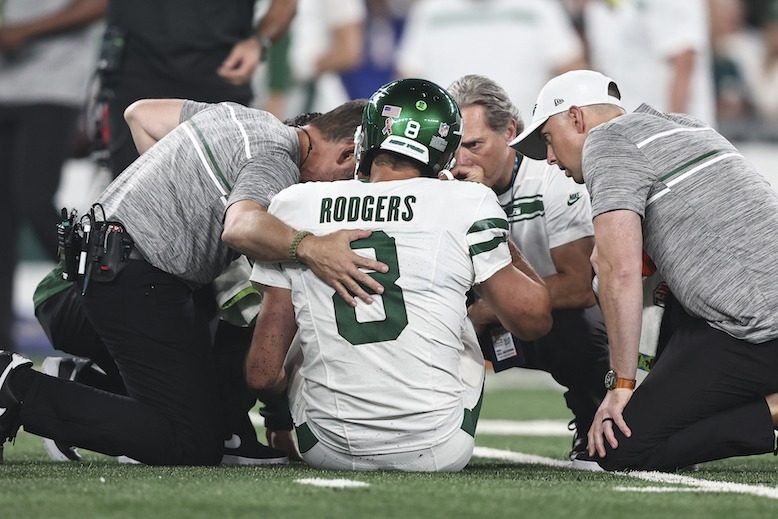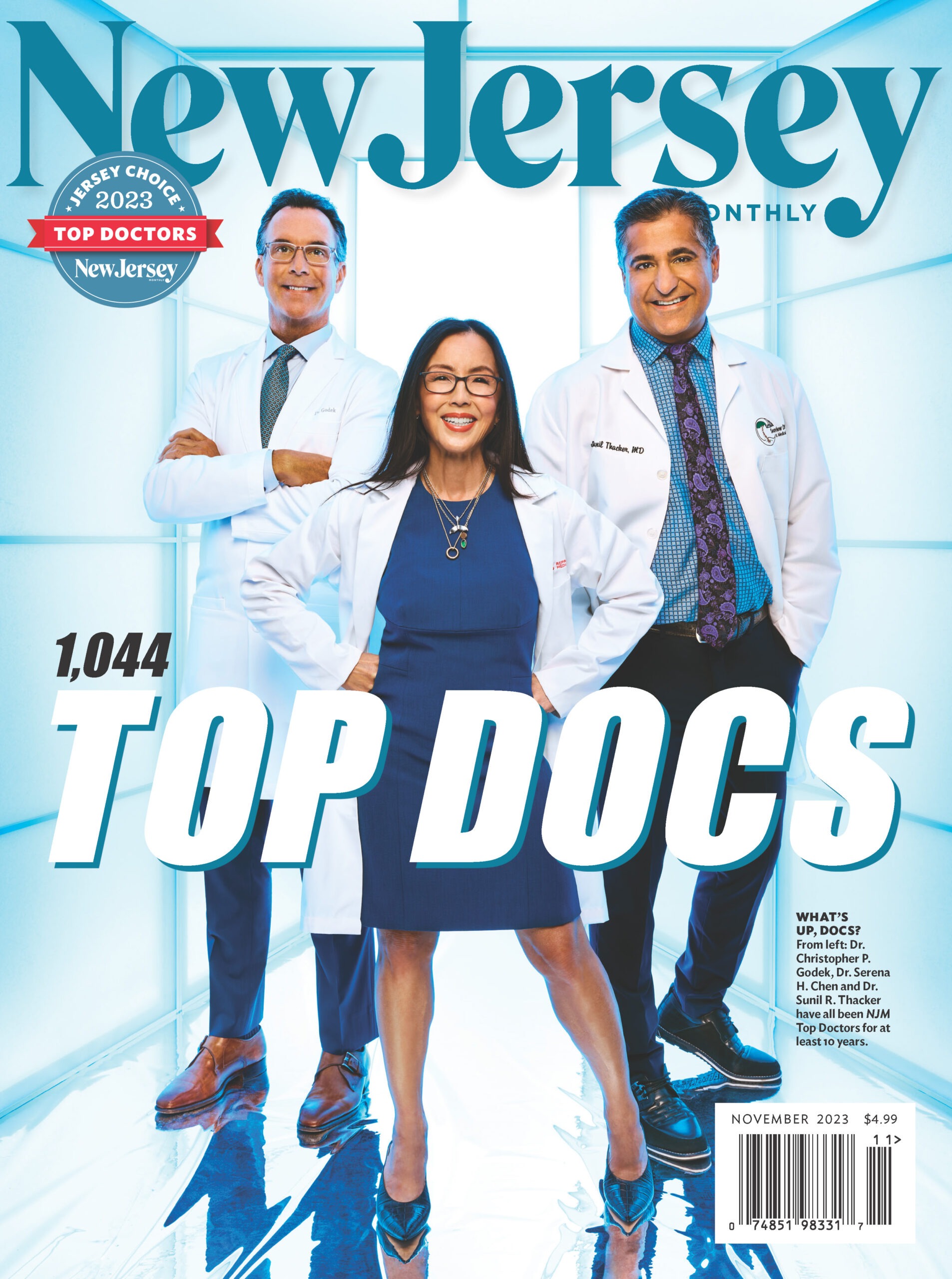
It was one of the most devastating injuries in New York and New Jersey sports history. In his first game with the New York Jets, Aaron Rodgers, the legendary quarterback who was expected to lead Gang Green to the Super Bowl in 2024, went down at MetLife Stadium after only four snaps, tearing his Achilles tendon and getting sidelined for the entire season.
Just days later, on September 14, Rodgers underwent surgery performed by the renowned Dr. Neal ElAttrache, a Los Angeles orthopedic surgeon who has operated on other athletic superstars, including Tom Brady and the late Kobe Bryant.
“I’m completely heartbroken and moving through all of the emotions, but deeply touched and humbled by the support and love,” Rodgers wrote on Instagram after his injury. A day after his surgery, Rodgers, 39, said the procedure “went great” with Dr. ElAttrache, whom Rodgers dubbed the “GOAT,” or greatest of all time.
[RELATED: Aaron Rodgers Revealed as Mystery Buyer of NJ Mansion]
Injuries and medical issues are inevitable parts of the game for NFL players. But most fans know little about how these elite athletes are protected before, during and after games, until something like Rodgers’s injury brings some of that information to light.
The team physicians for the Jets, the Giants, and the 30 other teams in the NFL must be as prepared as the players. “It’s a 24/7 commitment. You’re always on call, and you need to be available to the players, the coaches, the staff,” Dr. Damion Antonio Martins, head physician for the Jets, told New Jersey Monthly in an interview conducted before Rodgers’s injury. “I warn [medical] fellows: If you are a 9-to-5 person, sports medicine is not for you.”

Buy our November 2023 issue here. Cover photo: Brad Trent
Atlantic Health System, which has a multiyear partnership agreement with the Jets, did not respond to our request for comment regarding Rodgers’s injury.
[RELATED: New Jersey’s Top Doctors]
PAGING DR. NFL
Ronnie P. Barnes has seen the evolution of medical care for NFL players during his four-decade career with the New York Giants.
When Barnes joined the Giants’ medical staff in 1980 as athletic trainer, he worked with one orthopedist, one medical doctor and one assistant trainer. Now, each team has about 30 game-day medical professionals on the sidelines.
“There’s no limit. The NFL talks about 30, but in some places, it’s a lot more,” says Barnes, now senior vice president of medical services and head athletic trainer for the team. “We’ve been increasing not only the care, but the knowledge in sports medicine astronomically over the years, and we’re still growing.”
In addition to Barnes, the Giants’ medical staff includes six athletic trainers, three of whom have doctorates of physical therapy and are responsible for the rehabilitation of athletes; a primary care physician; a primary-care fellow; and orthopedic surgeons. Also present on the sidelines during games are emergency room physicians, paramedics, a chiropractor and an airway-management specialist.

Ronnie B. Barnes is the senior vice president of medical services and head athletic trainer for the Giants. Photo courtesy of the New York Football Giants
A gastroenterologist is on the field before games—did a player vomit because of nerves or illness?—and is on call in the stands all four quarters. An ophthalmologist is on call, but not in the stadium. And the NFL requires each team to have an unaffiliated neurotrauma consultant on the sidelines to evaluate any player who may have a concussion. According to the NFL, there were 149 concussions suffered during the 2022 season across all teams, an increase of 18 percent over the previous year.
Barnes says additional doctors on the medical roster can include a hand surgeon, a spine surgeon and a spine neurosurgeon.
The most dramatic addition to the Giants medical team came in 1986, after tight end Mark Bavaro broke his jaw during a game. “[After Bavaro returned to play], the dentist was there [on the sidelines] in the event that we needed to cut some of the wires, if he got sick or, you know, couldn’t breathe,” Barnes says.
A dentist stayed on the sidelines for the rest of that Super Bowl-winning year, but now one sits in the stands, with tickets provided by the Giants.
When it became clear that Rodgers had been injured during that September 11 game against the Buffalo Bills, medical staff immediately rushed to his aid, and he was helped off the field at MetLife Stadium.
INTENSE TRAINING
Like the players, the medical staff works hard at training camp over the summer, handling heat illness and other issues that arise as the athletes get ready for their season.
Martins as well as Dr. Dean W. Padavan, associate team internist, are doctors working for Atlantic Health System, which has a multiyear partnership agreement with the Jets. They staff the Jets’ sparkling training facility in Florham Park—the setting of the recently aired season of HBO’s Hard Knocks, which was filmed during training camp and showed Rodgers in all his glory—evaluating players who may feel ill and administering testing.
The medical teams also have their own training every spring, making modifications as needed to improve their care plan for the following season.
On game days, the doctors start their day three to four hours before kickoff, checking to see if the athletic trainers need anything and evaluating any player who does not feel well. The NFL’s pre-play 60-minute meeting is “an essential checkpoint to ensure officials, team medical staff and game-day medical personnel are aware of all in-game player health and safety procedures and resources,” according to the organization.
“We meet outside the officials’ locker room, and the officials, the head referee, is there. That is so important, because if they recognize something, they can let us know,” Barnes says. Throughout each game, everyone involved is alert to a potential injury or problem with a player.
During the game, the physicians have designated areas at the two 30-yard lines and generally stay at their spot, while athletics trainers will move up and down the sidelines following the ball, if they are not up in the booth.
After the game, the physicians typically stick around for an hour or two. “If there were any injuries or issues during the game, players are seen immediately and then evaluated,” Padavan told us in an interview conducted prior to Rodgers’s injury.
The physicians travel with the team to away games, but there is also a local doctor designated as the VTML, or visiting team medical liaison. The VTML can write prescriptions, which the traveling doctors can’t do in another state, and escalate care to a local hospital when necessary.
Doctors working for pro teams know they have dream gigs, but the public may not realize how intensive the work is.
“It’s an amazing job. I’m not gonna lie,” says Padavan. “But there’s a lot of help and support that goes behind it. I think a lot of people who don’t do it maybe don’t understand how much work goes into it. So you have to love it, and we do.”
BUILDING BONDS
The medical staff strives to build trust with the players, a bond that is fostered by the doctors eating meals with the team and staying at the same hotel for away games.
“Sports is a real community. They get to know you, and I think the most important thing is for them to know that you really care,” says Barnes, who was inducted into the Giants Ring of Honor last year.
Dr. Kameno Bell, an emergency medicine physician with the Giants, believes his own playing days help him relate to the players. “They can confide in me more casually, maybe, than some others,” Bell says.
Bell was a walk-on football player at the University of Illinois and was then drafted by the Miami Dolphins in the 12th round in 1992, spending two years in and out of the team’s system, mostly on the practice roster. Bell says he saw a “frustrating, fledgling career, trying to get my foot on the playing field in football,” and decided to go to medical school, taking the entrance exam while in training camp in Miami.
He had been pre-med at the University of Illinois and returned there for medical school. “Half the class knew who I was when I walked in, and they were like, ‘What are you doing here and not playing football?’” he recalls. “I would have rather remained anonymous.”
In school, he switched his concentration from surgery to emergency medicine and then had an opportunity for a fellowship in sports medicine. “It was kind of like coming home, combining medicine with sports, something I had done all my life,” he says.
A CAREER TOUCHDOWN
Turnover in NFL physician positions is rare. “It is one of those jobs where, once you are afforded the opportunity, people don’t leave—at all,” says Bell, 53, of Montclair.
When there is an opening, it is usually filled through a referral or a fellowship program at a medical school.
One of Bell’s coaches in college, Denny Marcin, became a coach for the Giants, leading Bell to connect with Barnes and eventually land a spot with Big Blue 15 years ago.
Padavan was first introduced to the Jets during a sports medicine fellowship with Atlantic Health in 2011; the team hired him in 2014.
During a fellowship in sports medicine at the University of Maryland, Martins served as a fellow team physician for the Baltimore Ravens. He began consulting for the Jets in 2002 and then started a full-time role in 2009. Martins is also the director of orthopedics and sports medicine at Atlantic Health.
Barnes was referred to the Giants in 1976 to help during summer camp while he was an athletic trainer during grad school at Michigan State University. In 1980, the New York team hired Barnes full time as head athletic trainer, then promoted him to vice president and then senior vice president of medical services.
Many of the team doctors work at a hospital, too. “It’s sometimes a little bit tricky to juggle, but we try our best so that we’re making sure that the players get the best care, as well as our patients in the clinic,” says Padavan, 43, of Morristown. Bell works full time at Hackensack University Medical Center and says the hospital is accommodating of his work with the Giants.
Some doctors also have roles with non-professional teams, such as those at high schools or colleges. One trait that distinguishes pro athletes is that they are highly motivated to get better. “It is very rewarding to see someone who has an illness, injury or issue overcome that because they’re highly motivated to get back to participation,” says Martins, 51, of Harding.
The medical staff has to rein in that enthusiasm at times. “I think our biggest job is protecting athletes from themselves,” says Barnes, noting players may want to return to the game after an injury before they’re fully rehabilitated. “That’s our job, to make sure that they can return safely, and that’s the job of everyone in the league.”
Enthusiasm of a different sort comes from the physicians’ families. Bell has three daughters, who are becoming more interested in football.
“Up until maybe a year ago, they wouldn’t have had a clue what I did. But as they get older, in school, their friends have found out, and now all of a sudden they have questions about it,” he says. “Everybody thinks it’s cool.”
Padavan, meanwhile, has two sons, ages 10 and 7, who watch every Jets game on TV, looking for their father on the sidelines.
Sharon Waters is a writer living in Bloomfield.
No one knows New Jersey like we do. Sign up for one of our free newsletters here. Want a print magazine mailed to you? Purchase an issue from our online store.



